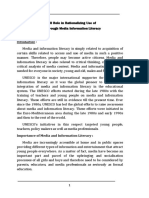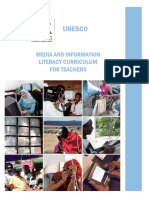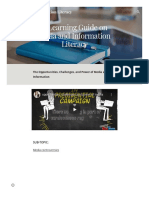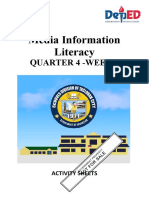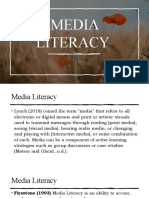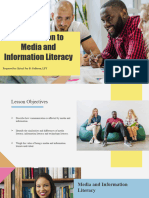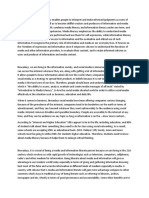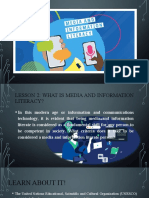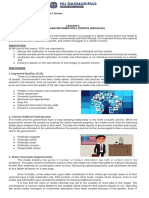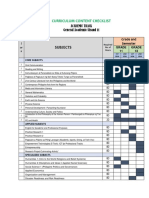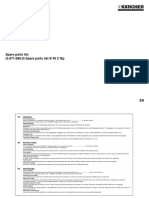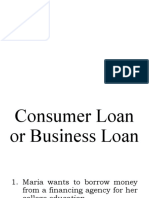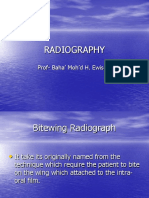Implications of Media and Information
What is It
A senior high school student might ask why Media and Information Literacy becomes a core subject
in the curriculum, while it could have been a specialized subject meant only for students who are
inclined for further academic studies in communication and media arts. The reason is simple: every
citizen must be media and information literate. One of the proponents for this conclusion dates back
to 2010, in the 3rd United Nations Alliance of Civilizations (UNAOC) Global Forum on May 2010 in Rio
de Janeiro Brazil. In one of its thematic sessions focusing on the social impact of media literacy,
media literacy was identified as “an empowerment tool that facilitates the active participation of
citizens in the political process of contemporary societies.” MIL is considered as a platform for social
inclusion, especially in the new digital environment, where the youth who are becoming more and
more exposed to social media, are challenged to become more involved participants in their
communities. Moreover, the new digital environment promotes a certain “participatory culture” that
empowers individuals to get actively involvedin democratic societies, thus enabling them to
participate in social discourse and deeper dialogue with their communities. Education is the key
factor to inform societies about the implications of media and information literacy. Thus, UNESCO’s
Teacher Training Curricula for media and information literacy was highlighted as the new resource
that identifies the core competencies and areas in general education associated with MIL. In 2010,
discussions on MIL were not yet highlighted in exiting curricula for general education around the
world. Therefore, the need educate people in this brand new perspective was seen as a much-
needed course of action. The end point of the 2010 Rio de Janeiro Forum was the identification of the
attributes of media and information literacy: a necessary source for social inclusion, and a platform
that facilitates the development of citizenship participation in pluralistic societies. All MIL initiatives,
whether within or beyond the formal education settings were regarded as key elements for the
promotion of intercultural dialogue.
What’s more
A senior high school student might ask why Media and Information Literacy becomes a core subject
in the curriculum, while it could have been a specialized subject meant only for students who are
inclined for further academic studies in communication and media arts. The reason is simple: every
citizen must be media and information literate.
One of the proponents for this conclusion dates back to 2010, in the 3rd United Nations Alliance of
Civilizations (UNAOC) Global Forum on May 2010 in Rio de Janeiro Brazil. In one of its thematic
sessions focusing on the social impact of media literacy, media literacy was identified as “an
empowerment tool that facilitates the active
participation of citizens in the political process of contemporary societies.” MIL is considered as a
platform for social inclusion, especially in the new digital environment, where the youth
who are becoming more and more exposed to social media, are challenged to become
more involved participants in their communities. Moreover, the new digital environment
promotes a certain “participatory culture” that empowers individuals to get actively involved
in democratic societies, thus enabling them to participate in social discourse and deeper
dialogue with their communities.
Education is the key factor to inform societies about the implications of media and
information literacy. Thus, UNESCO’s Teacher Training Curricula for media and information
literacy was highlighted as the new resource that identifies the core competencies and areas
in general education associated with MIL. In 2010, discussions on MIL were not yet
highlighted in exiting curricula for general education around the world. Therefore, the need
educate people in this brand new perspective was seen as a much-needed course of action.
The end point of the 2010 Rio de Janeiro Forum was the identification of the attributes of
media and information literacy: a necessary source for social inclusion, and a platform that
facilitates the development of citizenship participation in pluralistic societies. All MIL
initiatives, whether within or beyond the formal education settings were regarded as key
�elements for the promotion of intercultural dialogue.
when jobs grow, so does the economy. Employment or the lack thereof persists as an
economic problem in most developing countries like the Philippines. The media industry in
the age of information plays a vital catalyst role to address that.
Media and information for improvement of learning environment
Many believe that media and information have made learning easy, accessible and
inexpensive. Which these are true, the improvement in the learning environment brought by
media and information goes beyond convenience, availability and cost. Its true implication is
that it made the learning an object of desire. For so long, the concept of learning has been a
sores subject for many. This is not because everyone is just innately opposed to learning -in
fact, the birth of the information age proves the exact opposite- but because the learning
environment people were exposed to is simply unattractive. For so long learning has been
perceived as a tedious yet necessary part of everyone/s lives. Learning is schools meant
understanding – or at least attempting to- subjects for the sake of passing or getting good
grades. One’s education is given importance because it is pre-requisite to a good which is
then equated to a good life. Traditional learning environments have caused people in
general to lose appetite for knowledge. Luckily, media and information have cleansed
society’s palate and have reinvented learning.
Media does not force feed information to unwilling receivers; instead, media has made
information sought after. By offering a wide variety of content through various platforms,
there is information that would appeal to everyone. The media also made learning a choice
instead of a necessary evil. After all, no one is commanded “google” a topic or enroll on a
certain online course, people who do so chose to do it. Since the media is a source of
information and information age is characterized by the abundance of data, media and
information have been closely linked to the improvement of the learning environment in the
present age. A media and information literate individual take advantage of this to further his
or her lifelong learning process.
Media and Information individuals as more cohesive social units
The concept of unit cohesion stems from a military concept of the bond soldiers have that
makes them more effective in working together to complete a mission. Media and
information literate individuals are said to be more cohesive social units than those who are
not. By keeping them informed, as well as connecting them in ways that were not possible
before, media and information literates becomes more cohesive social units. This creates a
bond that does not only have relational implications but also creates societal impacts.
The media is said to have the power to affect social change. While this is true, it is not the
media that does the heavy lifting to create change in society, it is the individuals in the
society who developed a clamoring need for change because of media. The media and
information literate individuals sharing that same goal, development would not occur.
What I Have Learned
One of the most iconic songs made for a movie is Justin Paul and Benj Pasek’s “This Is Me”
from the movie “The Greatest Showman” (2017). This has become an anthem during the
time when diversity was the demand in many social institutions. Read the lyrics of the song.
You may even sing along with a lyric video via YouTube, then answer the questions that
follow:
Guide Questions:
1. “This Is Me” is a musical interpretation of the cries of the marginalized,
disenfranchised, the bullied and the outcast. Do you believe that this song does its
work to promote social inclusion?
2. Search various interpretations of this song through different platforms. Which members of society
are represented in the videos? If you do not have internet access, observe the picture of the cast of
“The Greatest Showman” below and use it to help you answer this question.
�3. Cite other media and information utilized to foster social inclusion in a pluralistic
society.








